At Monticello
Conventionally, the word “dumb” means mute or incapable of speech.1 In Greek tragedies, the role of a waiter is deliberately silent; with no words in the script, they cannot be perceived aurally.2 Occupying marginal roles in the play, the mute waiter remains idle until called upon by the master to execute a task. When summoned, they carry out orders “with little or no delay.”3 In waiting, the attending servant remains motionless onstage and becomes, as one scholar described, “almost ‘part of the scenery.’”4 As E. Cobham Brewer explains in his Dictionary of Phrase and Fable, a dumbwaiter is so named because “it answers all the purposes of a waiter, and is not possessed of an insolent tongue.”5
At Thomas Jefferson’s Monticello, three different devices came to be referred to as “dumbwaiters”: a small, tiered shelf on casters; a revolving door with semicircular shelves on one side; and a hoisting machine that carried bottles from the wine cellar up to the dining room.6 These contraptions took the place of human servants, performing, in the words of scholar Markus Krajewski, as “diligently and quietly as their flesh-and-blood counterpart only rarely successfully did.”7 For historian Alice Gray Read, Jefferson’s dumbwaiters were an integral piece of a larger idea of “separation” at Monticello. In the dining room, she writes, “guests could enjoy the fruits of Monticello Plantation and look over the landscape, framed as a pastoral vista in large windows. The freedom to speculate in conversations and to survey the landscape as spectators was encouraged by an architectural separation from the household and from the land. Jefferson created and controlled this separation by design of the dumbwaiter and the view.”8 Taking the place of enslaved domestic servants who prepared the food and wine, dumbwaiters delivered French-style fine dining to the table, ensuring the conversations among his guests remained, in the words of historian Howard W. Adam, “undampened by the presence of servants.”9 Margaret Bayard Smith, who was one of Jefferson’s regular guests, wrote that the removal of Black domestic workers from the dining room was a way to ensure “free and unrestricted” speech within the “enlightened” space.10 She vividly described the particular role of dumbwaiters at Monticello:
When [Jefferson] had any persons dining with him… the number of persons at table never exceeded four, and by each individual was placed a dumb-waiter, containing everything necessary for the progress of the dinner from beginning to end, so as to make the attendance of servants [enslaved laborers] entirely unnecessary, believing as he did, that much of the domestic and public discord was produced by the mutilated and misconstructed repetition of free conversation at dinner tables, by these mute but not inattentive listeners.11
As architectural historian Mabel O. Wilson points out in “Notes on the Virginia Capitol,” Jefferson believed that “Homo Sapiens Afer, Africans or Negroes” had “naturally inferior faculties.”12 Jefferson enslaved up to 200 humans at one time, and more than 600 over his lifetime, of whom he freed only seven.13 Using physiognomy, hair texture, and skin color as justifications, Jefferson held “physical and moral objections” to Black bodies and considered Black minds “dull, tasteless, and anomalous.”14 As a sociotechnical apparatus, the dumbwaiters at Monticello drew a physical “color line” between Black bodies, Black minds, Black ears, and Black tongues and white bodies, white minds, white ears, and white tongues. Worried that the free and unrestricted conversations among his guests would be tainted by the presence of Black faculties, the master of the house used the dumbwaiters in an effort to racially purify the dining space. With built-in filtering systems (in this case, the dumbwaiters) and strict protocols that regulated access, Jefferson’s controlled environment removed the presence of slavery through which Monticello was constructed and maintained.
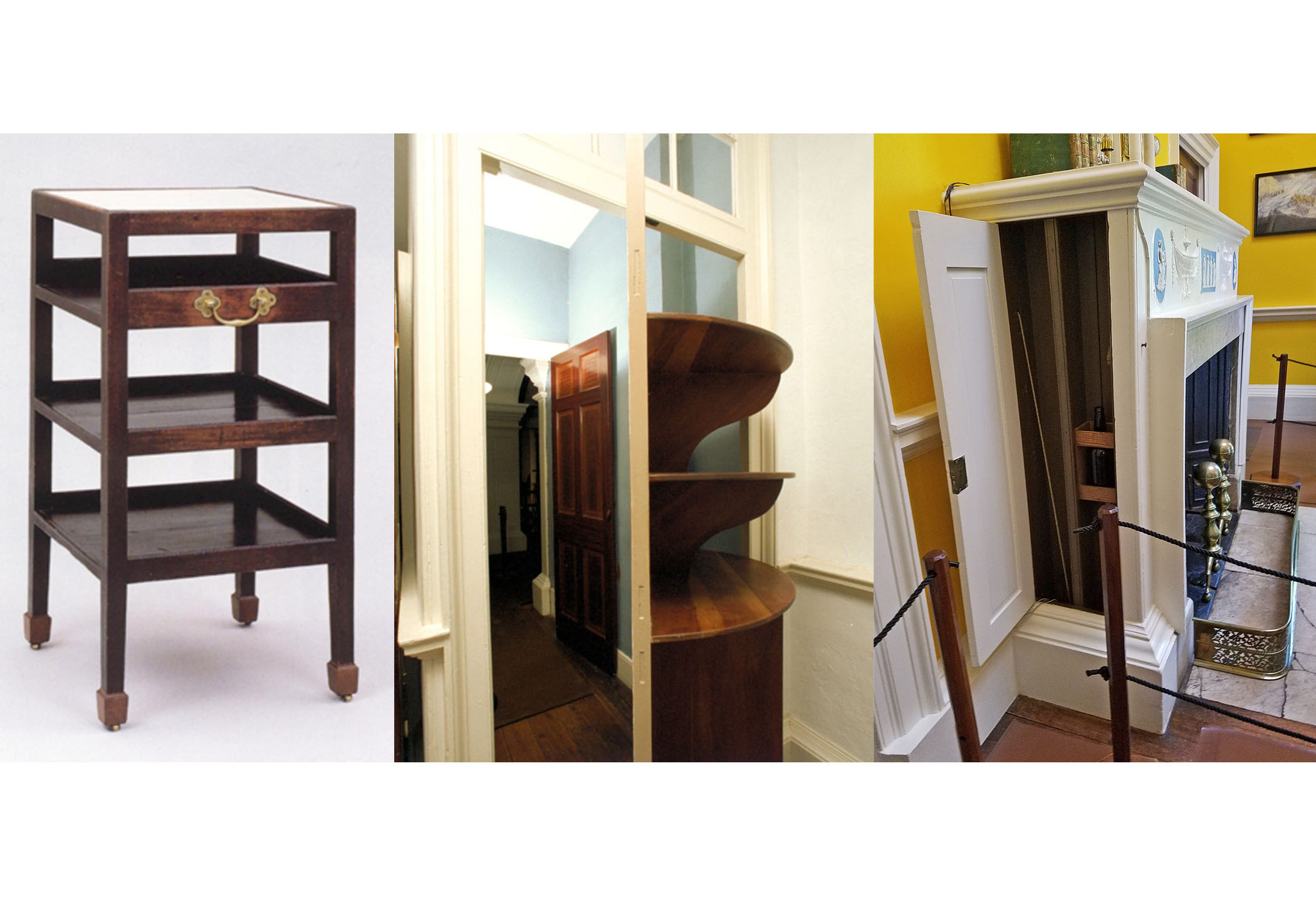
While Jefferson’s family and friends occupied the aboveground portion of the house, the movement of enslaved domestics was limited to a subterranean passage.15 In this way, the dumbwaiter was transfigured into a cultural technique; it operated within a vertical void to deliver objects from one level (height) to another. In plan, the dumbwaiter strategically occupied the intersection of the upper axis of Monticello’s entry and a lower axis of movement along the basement passage reserved for the domestic servants.16 Sectionally positioned above the kitchen and wine cellar, the dumbwaiters connected the formal rooms of Monticello to its service area. When its shaft intersected a horizontal floor plate, a door would open or remain closed to permit access.
Moving vertically between different floor levels, these dumbwaiters introduced distinctions such as inside/outside, above/below, field/house, periphery/center, speech/absence of speech. Acting as a gatekeeper, the vertical dumbwaiters’ narrow shafts selectively let in food and wine while keeping out those who prepared them. The dumbwaiters at Monticello were not laborsaving devices. The wine lift, for example, required a person to stand by throughout the dinner and manually load the wine in the basement cellar, while the revolving door only worked its magic after the food was delivered onto its shelf from the kitchen. It ingeniously served to provide domestic drama for the guests while maintaining the environment free from Jefferson’s unwanted audience.
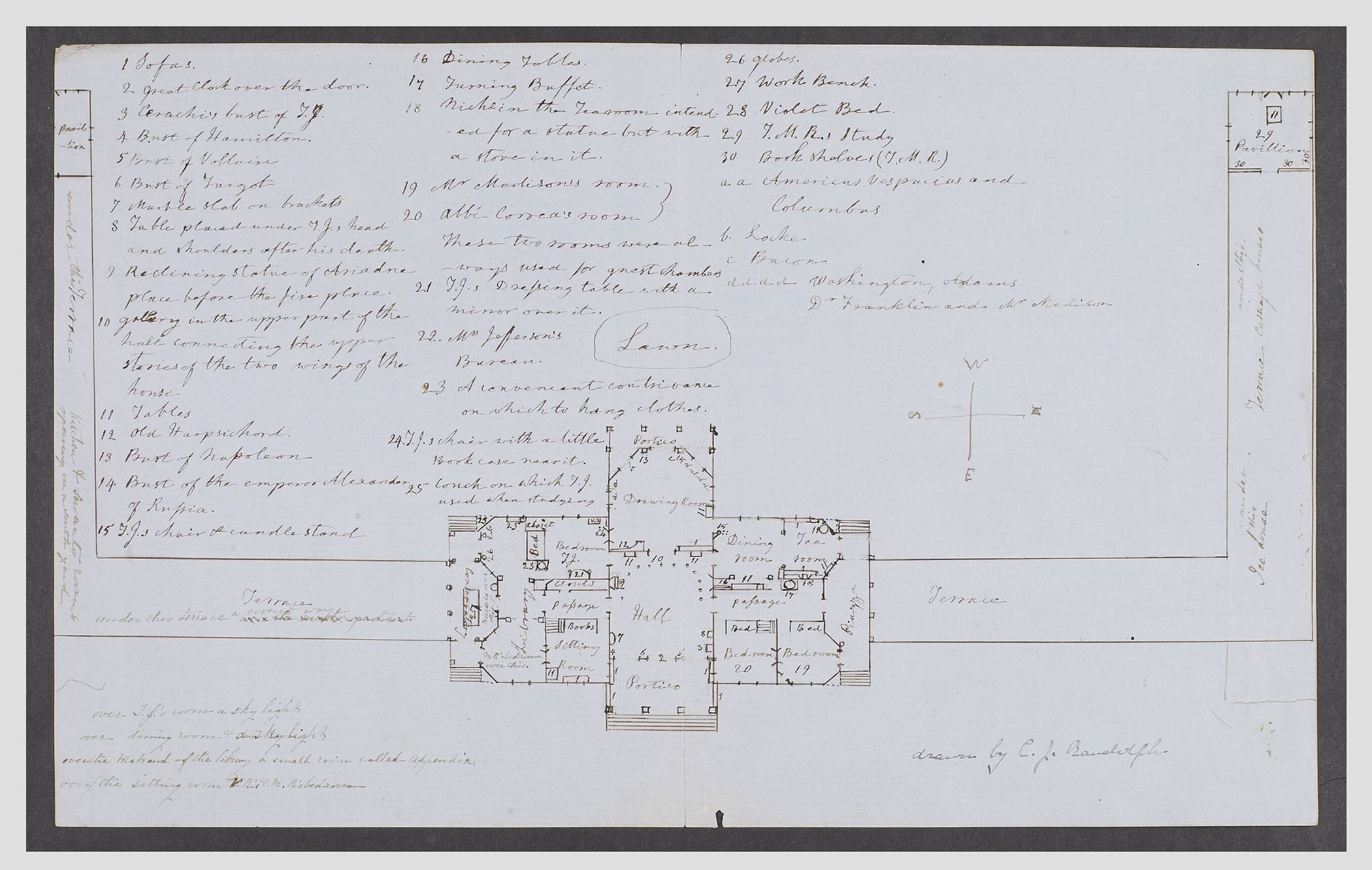
Following their installation at Monticello, the dumbwaiters continued to move through different spatial, cultural, and social spheres, delineating racial, gender, and class boundaries. Some of these distinctions became reinforced over time, while others were rendered obsolete. Like many other great American gizmos, dumbwaiters lack a general history beyond their early implementation.17 Scholars, particularly architectural historians, have extensively researched and interpreted Jefferson’s dumbwaiters, but have given less attention to how this technology has persisted in the nineteenth and twentieth centuries. Through historic photographs, trade catalogs, residence appraisals, declassified archives, congressional hearings, and news articles, I trace dumbwaiters in the construction of physical and intellectual worlds through “cross-sections” of US history after their appearance at Monticello.
In the House
Dumbwaiters’ wider application in homes, primarily private residences of bourgeois families, did not take hold until the early 1850s, when a number of patents were filed to improve the apparatus. A search of the records of the United States Patent and Trademark Office (USPTO) returns 104 patents filed between 1850 and 1899 that contain “dumbwaiter,” “dumb waiter,” or “dumb-waiter” in their descriptions.18 By the end of the nineteenth century, the dumbwaiter, understood as a vertical lift for objects, had become a popular topic in periodicals and trade catalogs.
Printed advertisements of dumbwaiters often featured women as the machine’s human operators. In Dunham, Carrigan & Co.’s 1888 catalog, for instance, Cannon’s Patent Dumbwaiter was advertised with a cut-away section. To demonstrate the dumbwaiter’s spatial mechanism, a female figure is shown pulling the rope as the waiter holding prepared food rises to the floor above. A similar illustration for Emerick’s Patent Dumb Waiters was included in the Butler Hardware Company’s 1890 catalog, with the section cut highlighting the dumbwaiter’s counterweight and its empty waiter operated by a woman. The gendered depiction was made more apparent in a later edition of Dunham, Carrigan & Co’s catalog. On the left-hand side of the spread, two women are pictured using the New York Safety Dumbwaiters, one pulling the rope and the other loading the dishes into its shelf. Directly to its right, a man is shown standing on Lockett’s Railroad Step Ladder, reaching for goods in a shop. The dumbwaiter is advertised to be “so simple in construction, and price[d] so low,” while the ladder is “perfectly steady [so that] a man can easily pull himself along while standing on the ladder without being obliged to get down.”19
The image of a woman waiting by the dumbwaiter persisted into the twentieth century, even as dumbwaiters became increasingly powered by electricity rather than by humans. In 1920, International Harvester Company, an American manufacturer of agricultural equipment, commissioned a series of photographs documenting domestic labor through its Agricultural Extension Department.20 One of the photographs, titled “Dumb Waiter in Farm Home of Mrs. John Bowers,” portrayed a woman unloading food from a dumbwaiter cart.21 The image is filed under folder “Home Economics” in the company’s photo collection. Documenting household routines in farmhouses across the United States, the series set out to evaluate, regulate, and promote “good domestic practices.” This intent was made evident through the original typewritten caption of another photo in the same collection, which depicts a sanitary garbage pail attached to a kitchen sink: “Kitchen Katch-all. If farm women gave a little more time and thought to the equipment in their kitchen much of the so-called drudgery would be eliminated.”22 Kitchen tools like the dumbwaiter and garbage pails were advertised to assist “the farmers and their wives” to “have better farms, better schools, better health, and better homes.”23 Printed next to modernized farming equipment in International Harvester’s promotional materials, the photograph of Mrs. Bowers operating the dumbwaiter signaled a new ideal of efficiency in American homes.

Not only did the dumbwaiter support “good” domestic behavior, it could also punish bad habits. The 1906 Stereographs of American Life and Humor by the Standard Scenic Company portrays a series of dramatic moments staged in front of a dumbwaiter.24 The images tell the story of a man cheating on his wife with the new French housemaid. The maid, whose job is to provide domestic service in a bourgeois home, “misbehaves” by having an affair with the master of the house. The caption tells us how the story ends: “Wh-i-r-r-r, Crash, and a Woman’s Scream from Dumbwaiter.”25 This dumbwaiter is a disciplining tool that punishes the misbehaviors within the domestic sphere. Three “waiters” were, in fact, present at the scene of the maid’s punishment—the lifting device, the falling maid, and a Black male waiter who silently witnesses the entire affair. During the husband and wife’s confrontation, he stands dejectedly near the dumbwaiter; his blank look and stiff posture echo the deer head mounted above the apparatus. This disquieting parallel between a machine, a taxidermized animal, and a silent human waiter can be found in other accounts of the term “dumbwaiter.” For instance, a Harper’s Weekly supplement from October 1874, titled “Dumb-Waiter,” included an illustration of a taxidermized bear standing at attention as it presents champagne on a silver platter.26
Dumbwaiters, in other words, continued to bear witness to racial subordination and gender inequality in early twentieth-century America. The dumbwaiter became not only an integral part of US home economics in the nineteenth century but also a visual metonymy in the sociocultural depiction of race, gender, and domestic labor in printed media. Their increasing domestic application continued to facilitate the silencing of those who served, imposed by those who were being served.

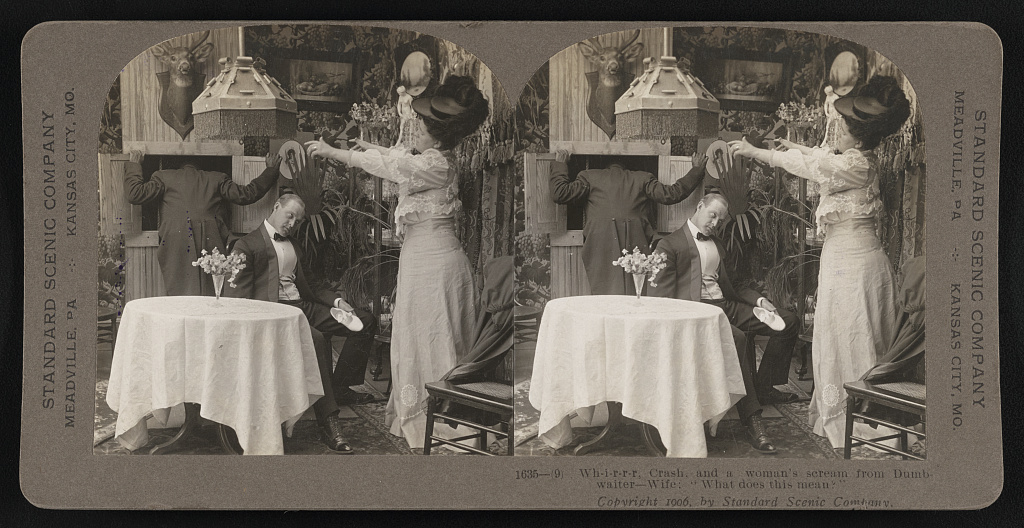
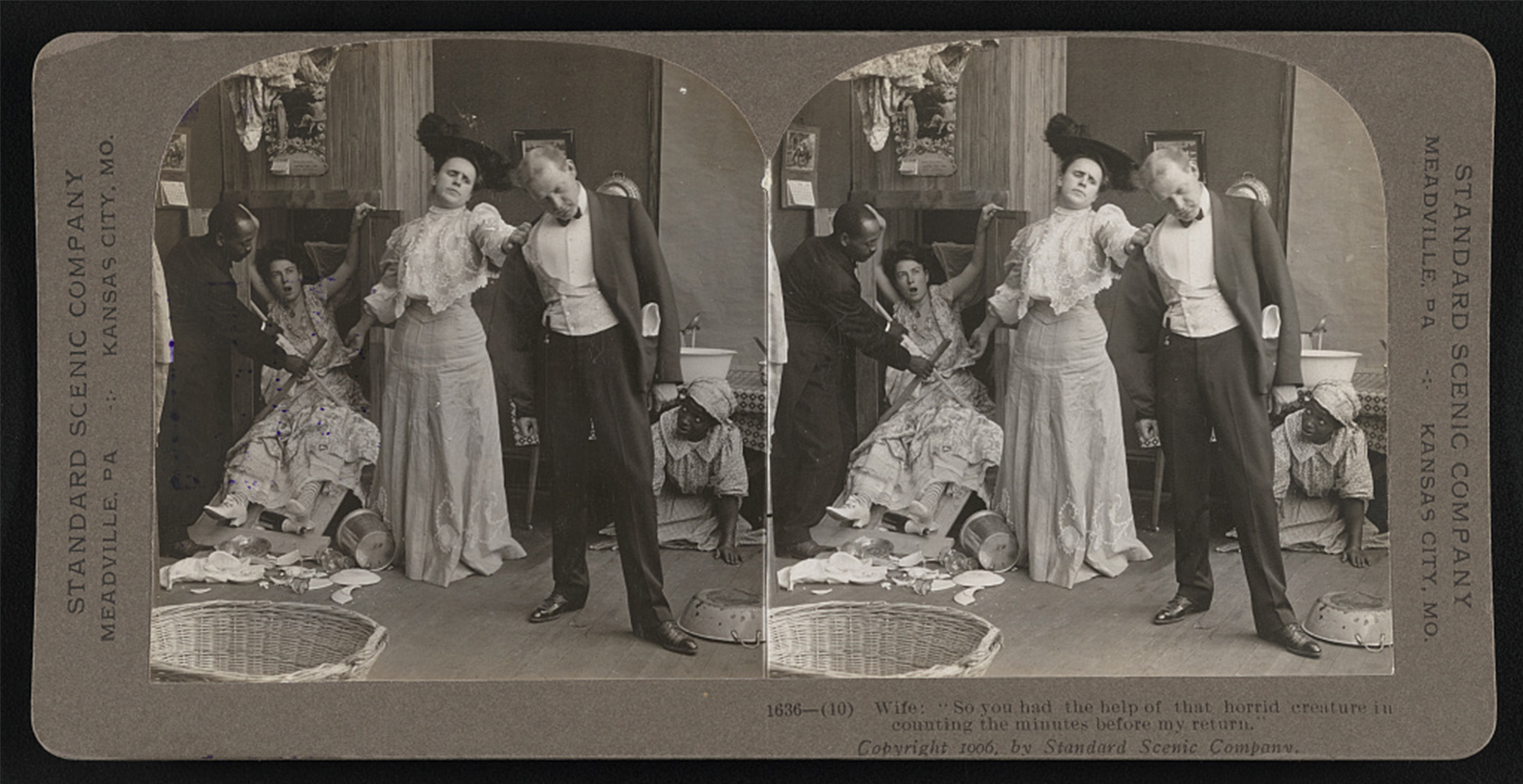
The Paper Flood
“To serve,” writes historian Markus Krajewski, “is to deliver messages but also to filter them; to open doors but only in order to close them; to follow orders but also to anticipate them; to attend an event in full gala livery and thus represent the wealth of the master but also to undertake special missions going via secret passages and green baize doors.”27 Like its human counterparts, the dumbwaiter delivered information on top of goods and meals. As the twentieth century progressed, dumbwaiters’ capacity to move higher and faster increased. At the same time, printing and copying technology allowed for an unprecedented amount of paperwork to be produced for administrative processes. Thus the delivery of proliferating printed matter via dumbwaiter became common in the day-to-day operations of a number of businesses and government agencies.
As a machine that moved files, the dumbwaiter managed information at intersections of vertical and horizontal communication channels. A 1954 New York Times article announced the installation of a dumbwaiter at the UN Secretariat at the cost of $58,000.28 Collecting files from a horizontal system of conveyor belts and pneumatic tubes located in the basement, the dumbwaiter moved up and down 483 feet between the Secretariat building’s top and bottom floors.29 With the capacity to carry 300 pounds of files per ride, the device was “the world’s tallest mechanical messenger,” the article stated.30 A few years later, in San Francisco, the first commercial dumbwaiter for the United States Postal Service’s Vertical Improved Mail (VIM) system was installed at the twenty-story Crown Zellerbach building in 1963.31 Requiring only one postal worker to operate the ground-floor mailroom, the system was designed to reduce the number of mail carriers needed to service tall office buildings.32 From a manually operated moving cupboard that transported fine dining objects, the dumbwaiter evolved into an electric-powered commercial lift to distribute documents and files, enabling the consumption of information rather than food.
Occupying spatial thresholds where unsorted information was labeled, classified, and redistributed, the dumbwaiter became a site of both intelligence and secrecy. A 1930s interior photo of Turpentine & Rosin Inc.’s office showed a dumbwaiter right next to the company’s fireproof file room. The dumbwaiter, together with a lockbox, protected internal documents from leaking or corruption. Considering its early history as a means to ease paranoia about spying servants, the association with file safety and institutionalized secrecy is perhaps not surprising. These qualities made the dumbwaiter an obvious candidate for use within the Central Intelligence Agency (CIA) and its immense demands for the collection, encryption, and storage of information. The 1947 National Security Act charged the agency with evaluating and disseminating intelligence affecting national security.33 In the CIA’s early years, control of classified information relied on the organization’s multilevel spatial infrastructure. Tracing the “dumb” waiter within the CIA’s information architecture thus offers insights into the handling, filtering, and redistribution of intelligence in the United States since the 1950s.
Dumbwaiters were implemented at the CIA’s Langley, Virginia, headquarters according to the 1958 construction outline specifications by Harrison & Abramovitz Architects and Frederic R. King, Associated Architect. The report gave detailed instructions on fire safety, preconstruction demolition, building structure, insulation, waterproofing, and finishes for the new headquarters. Under item 17, “Interior Partitions,” the document specified “fire rated masonry block partitions” for the enclosure of dumbwaiter and conveyor shafts.34 In addition, a chart detailing dimensions, speed, load, and travel distance of each lifting device within the facility was attached.35 According to this chart, a dumbwaiter with a contract load of 500 pounds could move files between the ground floor and the fourth floor at a speed of 50 feet per minute.
The device was also implemented at the CIA’s Archives and Records Center (A&RC) to move large quantities of inactive records.36 The A&RC hosted approximately 82,859 cubic feet of paper files by 1966, which equated to 10,358 four-drawer legal-size safes.37 As part of the department’s management improvement plan, a dumbwaiter was installed between its first and second floors to save its staff “30 man-days per year.”38 Like its predecessors that delivered food and wine, the dumbwaiter at the CIA was evaluated based on its ability to replace human operators. The same unit—action—was used to monitor both the department’s mechanical lift and its human laborers. An action equated “one cu. ft. of records received,” “one cu. ft. of records destroyed” or “one reference finished.”39 The efficiency of the mechanical dumbwaiter and of the staff thus came to be judged through the physical size of the paper files transformed by their work.
The addition of dumbwaiters did not satisfy the CIA’s increasing demand for file processing. From 1938 to 1965, the volume of paper records at the CIA rose by 500 percent.40 Accommodating this growth with limited people, machines, space, and overhead budget was nearly impossible. Underlining the conflict between the CIA’s continuously growing workload and limited staff, one employee complained, “Most of us plead that we are so overloaded that we cannot take on another piece of paper or another form. Individual components strive valiantly to improve the effectiveness of their use of manpower by regulating themselves a little better in one respect or another, but the paper flood does not diminish.”41
Acting as a moving body in the agency’s streamlined information system, the dumbwaiter became as overworked as its human counterparts. A 1966 memo submitted to the Engineering Department by the Archives and Records Center put work orders on the “dumb waiter” and the ventilation system in its facilities. The center’s staff stressed that the repairs were essential “for the health and moral [sic] of the employees,” which would also help to avoid deterioration of permanent CIA records stored at the center, and not just needed from an operations standpoint.42 The well-being of the employees, the dumbwaiter, and the archived files were shown to be interconnected through the management of the building’s environment. To maintain the health of encrypted files—the agency’s bureaucratic body—its staff and its equipment would have to be cared for as well.
The incorporation of dumbwaiters in the USPS’s Vertical Delivery Systems, the UN Secretariat, and the CIA saw a new era of modern bureaucracy built upon paper intelligence. Employed alongside human workers in information collection, sorting, and processing since the 1950s, dumbwaiters became deeply embedded in the daily operations of corporations and government agencies. At the CIA, narratives of human-machine alliances emerged in response to an increasing demand for productivity. Dumbwaiters were not only seen as mechanical tools to increase efficiency by the organization’s staff but as important nonhuman collaborators whose wellness needed to be considered.
At the Library of Congress
Some of the illustrations in this essay are sourced from the Library of Congress’s digital archives. Not only does the Library of Congress contain the most well-archived collection of documents on dumbwaiters, it has also employed the very device within its own information architecture, at the Main Reading Room in its Thomas Jefferson Building.43 Made to operate within a network of pneumatic tubes, conveyor belts, and underground book carriers, the dumbwaiter connects the main circulation desk to a subterranean information network under Capitol Hill. H. G. Wells, in his book The Future in America, described the book delivery system as “the wonderful mechanical organization that brings almost every volume in that immense collection within a minute of one’s hand.”44 Beyond the library’s own buildings, this system once served Congress and the Capitol building. Book requests were frequently made during congressional sessions, as Mary Simmerson Cunningham Logan recalled in 1901: “If in the midst of a speech it occurs to a Senator that he needs a certain book or the file of a certain newspaper, he has but to call a page, whisper his wish, and before he has delivered many more sentences, the page returns with the book or file.”45
A 2016 article published on the website Architect of the Capital provides a history of this information infrastructure.46 Whenever a book request was placed from the Capitol, the circulation desk received the volume from the stacks via a system of conveyor belts. “Through a dumbwaiter located in the boxy central cabinet,” the book descended to the control room below, where it was placed on a special carrier to be sent to the Capitol.47 Though the dumbwaiter was recently refurbished, the connected pneumatic tubes, conveyor belts, and book tunnels have either been removed for the Library of Congress’s new visitor center or fallen into disrepair since the early 2000s.48 “Frozen between the forces of bureaucratic inertia and historical preservation,” the dumbwaiter no longer delivers books and remains a mere visual detail in the reading room.49

In July of 2022, the Library of Congress Professional Guild warned that the dumbwaiter, along with the central circulation desk and control room, was at risk of removal.50 According to a plan to reconfigure the control room occupied by the library staff into an orientation space for visitors, the existing furniture and equipment would be replaced by an “oculus” through which visitors could view the Main Reading Room’s dome from the floor below.51 The change was first proposed in the Library of Congress’s 2018 Visitor Experience Master Plan and confirmed in the library’s 2023 Budget Justification.52 With a $60 million budget and the Architect of the Capitol’s support, the “Orientation Gallery / Welcome Area / Oculus” project underwent preliminary design development.53 Drawing sets were produced and construction was at one point scheduled to be completed in fall 2025.54 The library’s initial vision was made public during a 2019 presentation by the Librarian of Congress, Carla Hayden. Entering from street level, Hayden explained, visitors will arrive at the Orientation Space to view “[the Reading Room’s] arched stained glass windows, domed ornamental ceiling, balustrade of galleries above the alcoves, and some of the major figures who contributed to civilization” through the oculus.55 The designers hope that the spectacular view will inspire visitors to “have a better understanding of democracy in action, appreciate what it means to be a good citizen,” and see “Jefferson’s Library as the foundation of the Library.”56 (The proposal was scrapped in November of 2022 due to budget and fire safety concerns.57)
The Library of Congress Professional Guild has strongly objected to the redesign. Established in 1976, the organization consists of over 1,500 librarians, catalogers, archivists, curators, conservators, and IT specialists.58 Guild members consider the dumbwaiter to be an integral part of the history of clerical work.59 Citing Herbert Small’s 1897 Handbook of the New Library of Congress, they advocate for the preservation of the original circulation desk, dumbwaiter, and control room, which they call “the vital point, the kernel,” and the “heart” of the Library of Congress. These mechanisms, the Guild claims, “contain the real life of the institution” and without them, “there could hardly be a library.”60 A later statement released by the organization’s executive board further expressed the guild’s concerns about the proposal, which was considered to endanger the building’s “architectural integrity” and the Reading Room’s function “as a premier research space while prioritizing future visitors over the library’s current constituents, including researchers and library staff.61
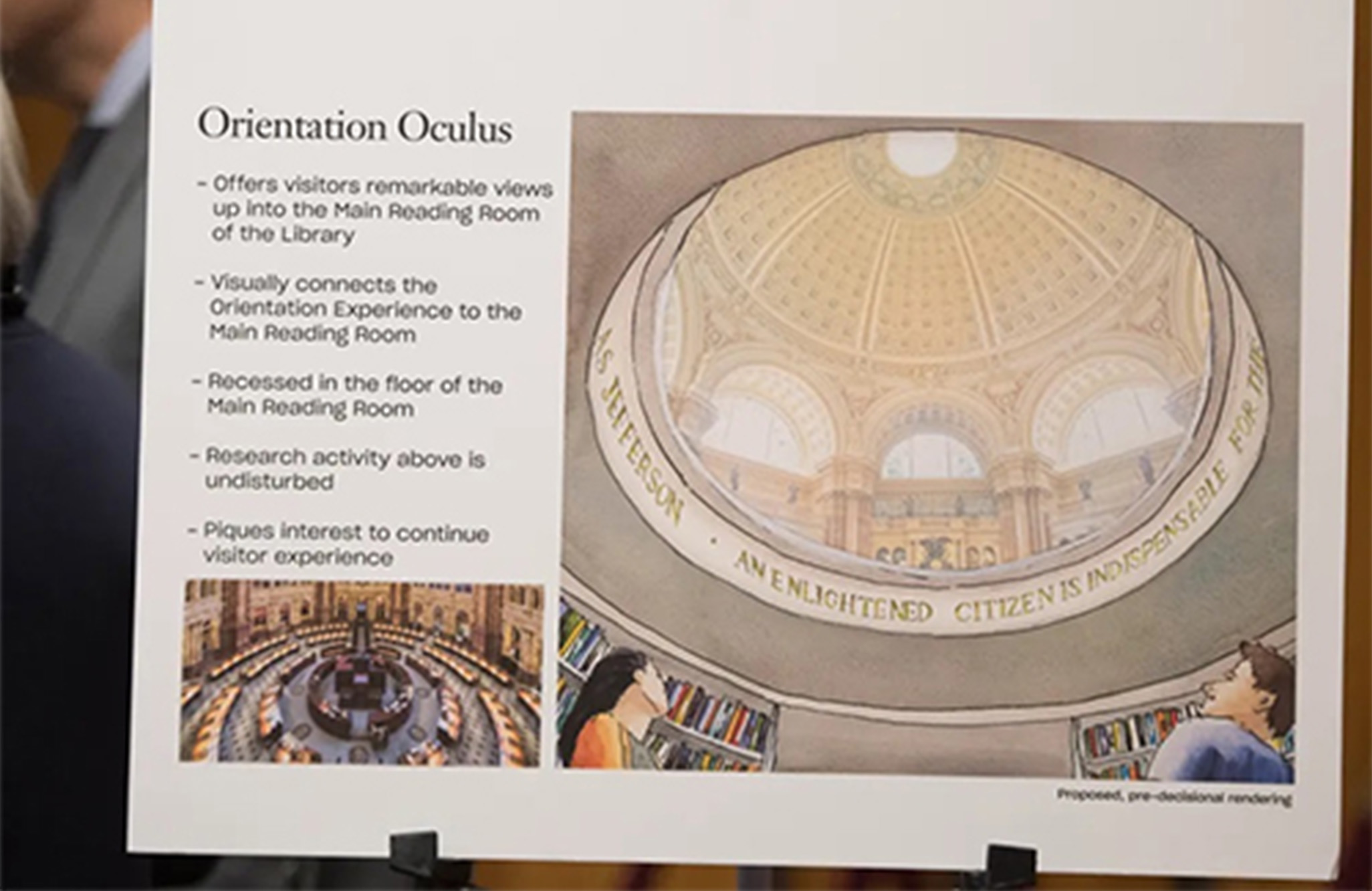
The now canceled redesign might be seen as a twenty-first-century attempt to reconstruct the knowledge world at the Library of Congress. By replacing the solid core (the dumbwaiter, the circulation desk, and the control room) with a void (the oculus), the proposal reconfigures the library with a new public in mind. With the removal of the dumbwaiter, the designers aim to open a splendid, unobstructed view of the stained-glass windows and domed ornamental ceiling. By replacing a central node of circulation of information, the oculus frames a horizontal picture plane through which the Library of Congress itself becomes an image. With thousands of archival materials now digitally scanned and made available online, it is perhaps fitting to replace the circulation desk and the dumbwaiter at the Library of Congress with a void. If we think of the dumbwaiter as a vertical shaft framed by four solid walls, an oculus may be considered as a version of the same basic form but with the walls infinitely thinned out. At the edge of this invisible boundary, the void grows taller, bigger, and increasingly untraceable. But if we get close to it and listen carefully, we may still hear the whispers from history.
It turns out that there is a close connection between this most recent proposal and the view from Monticello’s dining room. The Library of Congress was quite literally built upon Thomas Jefferson’s personal library at Monticello, beginning with the 6,487 volumes purchased from Jefferson in 1815 after the fire in the Capitol.62 As the architectural historian Reinhold Martin suggests, the dining room and library at Monticello together work as “the material substrate out of which an intergenerational republic of letters was built”; the silence in Jefferson’s dining room was echoed by the silence in his library, as both spaces “presuppose an agrarian order of property that included slavery as its conditions of possibility.”63 Much like Jefferson’s books, the dumbwaiter from Monticello made its way into the Library of Congress’s Thomas Jefferson Building, where it continued to occupy a central location as a spatial-technical device.
Looking back at the history of the dumbwaiter, we might still ask, by way of conclusion: what would it mean to replace the dumbwaiter in the Great Reading Room of the Library of Congress with an oculus? Would the apparatus’s physical disappearances diminish its previous impacts, or would this absence further anonymize, naturalize, and stabilize the social order, labor conditions, and knowledge models the dumbwaiter has helped to produce? Alternatively, what does it mean to preserve the dumbwaiter as the Guild has suggested? Will the device continue to function as part of the Library of Congress’s information infrastructure? Will it retire as most other delivery mechanisms in the Library’s building already did? What does it mean to place a void at the center of the “bureau of information for the entire United States”?64 What does one do with a retired dumbwaiter?
-
“Dumb Waiter,” in Encyclopedia Britannica, 1911. ↩
-
Markus Krajewski, The Server: A Media History from the Present to the Baroque, trans. Ilinca Iurascu (New Haven, CT: Yale University Press, 2018), 256. ↩
-
David Bain, Masters, Servants, and Orders in Greek Tragedy: A Study of Some Aspects of Dramatic Technique and Convention (Manchester: Manchester University Press, 1981), 2. ↩
-
Bain, Masters, Servants, and Orders in Greek Tragedy, 3. ↩
-
Ebenezer Cobham Brewer, Brewer’s Dictionary of Phrase and Fable, centenary ed. (London: Cassell, 1977), 312. ↩
-
Alice Gray Read, “Monticello’s Dumbwaiters,” Journal of Architectural Education (1984–) 48, no. 3 (1995): 171. ↩
-
Krajewski, The Server, 254. ↩
-
Read, “Monticello’s Dumbwaiters,” 168. ↩
-
Howard W. Adams, Jefferson’s Monticello (New York: Abbeville Press, 1983), 207. ↩
-
Margaret Bayard Smith, The First Forty Years of Washington Society, Portrayed by the Family Letters of Mrs. Samuel Harrison Smith (Margaret Bayard), ed. Gaillard Hunt (New York: Scribner, 1906), 387. ↩
-
Smith, The First Forty Years of Washington Society, 387–88. ↩
-
Mabel O. Wilson, “Notes on the Virginia Capitol: Nation, Race, and Slavery in Jefferson’s America,” in Race and Modern Architecture: A Critical History from the Enlightenment to the Present, ed. Irene Cheng, Charles L. Davis, and Mabel O. Wilson (Pittsburgh: University of Pittsburgh Press, 2020), 37. ↩
-
Wilson, “Notes on the Virginia Capitol,”40. ↩
-
Thomas Jefferson, Notes on the State of Virginia (Richmond, VA: J. W. Randolph, 1853),149–51, quoted in Wilson, “Notes on the Virginia Capitol,” 37–38. ↩
-
Wilson, “Notes on the Virginia Capitol,” 37. ↩
-
Read, “Monticello’s Dumbwaiters,” 168–69. ↩
-
Reyner Banham, “The Great Gizmo,” Industrial Design (Archive: 1954—1978) (Cincinnati: F & W Publications, September 1965). ↩
-
Dunham, Carrigan & Co.’s Illustrated Catalogue and Price List of Builders’ and Heavy Hardware, Iron, Steel, Pipe, Machinists’ and Mining Supplies Etc. Etc., 1888, 212. ↩
-
The International Harvester Company established the Agricultural Extension in the early 1910s to develop programs and publications designed to teach home economics, farming methods, and animal husbandry to rural farmers as part of the company’s promotional efforts. MCC MSS 13Z, Album 57, Box 31, Folder 6, Wisconsin Historical Society, link. ↩
-
Woman with Dumbwaiter | Photograph, November 31, 2003, Wisconsin Historical Society, link. ↩
-
“Sanitary Garbage Pail | Photograph,” Wisconsin Historical Society, November 31, 2003, link. ↩
-
International Harvester General Catalog No. 20 (Wisconsin Historical Society, 1920), 28. ↩
-
Standard Scenic Company, “Stereographs of American Life and Humor,” 1906, link. ↩
-
“Wh-i-r-r-r, Crash, and a Woman’s Scream from Dumbwaiter—Wife: ‘What Does This Mean?’” Standard Scenic Company, “Stereographs of American Life and Humor.” ↩
-
“THE DUMBWAITER,” Harper’s Weekly, October 31, 1874. ↩
-
Krajewski, The Server, 80. ↩
-
“Tall Dumbwaiter Moves U.N. Papers: Conveyor Belt and Pneumatic Tubes Also Handle Daily Flow of Secretariat Mail,” New York Times, November 25, 1954. ↩
-
“Tall Dumbwaiter Moves U.N. Papers.” ↩
-
“Tall Dumbwaiter Moves U.N. Papers.” ↩
-
“Dumbwaiter to Deliver Mail in High-Rise Offices,” Science News-Letter 84, no. 7 (1963): 102. ↩
-
“Dumbwaiter to Deliver Mail in High-Rise Offices,” 102. ↩
-
Harrison & Abramovitz Architects and Frederic R. King, Associated Architect, “Construction Outline Specifications for Central Intelligence Agency Headquarters Building, Langley, Virginia,” January 17, 1958. ↩
-
Harrison & Abramovitz Architects, “Outline Specifications for Elevator and Dumbwaiter Work,” January 31, 1958, link. ↩
-
A record is considered inactive when “no more than one reference per month was made to it.” See “Minimum T/O for the CIA Archives and Record Center,” December 1966, link. ↩
-
“Operating Budget FY 1967 and Preliminary Estimates for FY 1968–FY 1972,” February 9, 1966, link. ↩
-
“Minimum T/O for the CIA Archives and Record Center,” 6–7. ↩
-
“Minimum T/O for the CIA Archives and Record Center,” 4. ↩
-
“Minimum T/O for the CIA Archives and Record Center,” 6. ↩
-
“Proposal for the Rapid Transmittal of Information Reports and Customer Reactions,” 18. ↩
-
“Operating Budget FY 1967 and Preliminary Estimates for FY 1968–FY 1972.” ↩
-
Zeynep Çelik Alexander, “Stacks, Shelves, and the Law: Restructuring the Library of Congress,” Grey Room 82 (February 2021): 23; Josh Levy, “The Book Delivery System at the Library of Congress | Unfolding History: Manuscripts at the Library of Congress,” April 21, 2022, link. ↩
-
H. G. Wells, The Future in America: A Search After Realities (London: Chapman & Hall, 1906), 331. ↩
-
Mary Simmerson Logan, Thirty Years in Washington; or, Life and Scenes in Our National Capitol (Hartford, CT: A. D. Worthington, 1901), 434. ↩
-
Elliot Carter, “Conveyor Belt Delivery Systems at the Library of Congress,” Architect of the Capital, link. ↩
-
Carter, “Conveyor Belt Delivery Systems at the Library of Congress”; and Levy, “The Book Delivery System at the Library of Congress.” ↩
-
Carter, “Conveyor Belt Delivery Systems at the Library of Congress.” ↩
-
Carter, “Conveyor Belt Delivery Systems at the Library of Congress.” ↩
-
Library of Congress Professional Guild, “A National Treasure at Risk?” July 22, 2022, link. ↩
-
Library of Congress Professional Guild, “A National Treasure at Risk?” ↩
-
“Library of Congress Fiscal 2023 Budget Justification Submitted for Use of the Committees on Appropriations,” 24, link. ↩
-
“Library of Congress Fiscal 2023 Budget Justification Submitted for Use of the Committees on Appropriations,” 207. ↩
-
“Library of Congress Fiscal 2023 Budget Justification Submitted for Use of the Committees on Appropriations,” 207. ↩
-
Carla Hayden, “Statement of Carla Hayden, the Librarian of Congress, Before the Committee on Rules and Administration, United States Senate, ‘Annual Oversight of the Library of Congress,’” March 6, 2019, 3, link. ↩
-
“Statement of Carla Hayden, the Librarian of Congress, Before the Committee on Rules and Administration, United States Senate, ‘Annual Oversight of the Library of Congress,’” 3. ↩
-
“The Library of Congress Scrubs the Oculus Project,” Capitol Hill Corner, December 13, 2022, link. ↩
-
Library of Congress Professional Guild, “A National Treasure at Risk?”; and Alexander, “Stacks, Shelves, and the Law,” 24. ↩
-
Alexander, “Stacks, Shelves, and the Law,” 24. ↩
-
Alexander, “Stacks, Shelves, and the Law,” 24. ↩
-
“Out of the Ashes: A New Library for Congress and the Nation,” online exhibition, Library of Congress, May 8, 2015, link. ↩
-
Reinhold Martin, “Drawing the Color Line,” in Cheng, Davis, and Wilson, eds., Race and Modern Architecture, 71. ↩
-
Herbert Putnam, “What May Be Done for Libraries by the Nation,” Library Journal 26, no. 8 (August 1910): 14, cited in Alexander, “Stacks, Shelves, and the Law,” 23. ↩
Shirley Dongwei Chen is a designer and researcher based in New York. Her recent projects explore how working bodies are registered and concealed in architectural bodies of work. She is particularly interested in the historicization of design and building technology. Shirley graduated from the Princeton School of Architecture, where she edited Pidgin. Her writings have appeared in Roomonethousand, POOL, Paprika!, and Lunch Journal, among others. Her work has been exhibited at a83 gallery in New York, Tbilisi Architectural Biennale, Trinity Buoy Wharf, the Gallery at Arts University Bournemouth, and the Arts Institute, Plymouth University. Shirley is one half of the design collaborative DoZa.
This essay was initially developed for 577/MOD 577 Investigations: Building Cultivation (Fall 22, Princeton School of Architecture). I want to thank Professor Sylvia Lavin and Assistant-In-Instruction Reese Greenlee for their generous suggestions on the initial piece.
